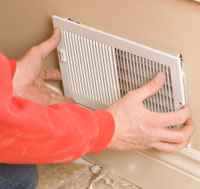8 Reasons to Turn on Your HVAC
In the interests of reducing utility costs, in the rush of a construction schedule, or even in opinions about pre-occupancy necessity, leaving heating and ventilation systems (HVAC) off can seem like a valid option for the building team that is interested in efficiency and in maintaining bottom-line costs. However, in the long run there are compelling reasons to turn on, and leave on, all the environmental controls for a building space. This is especially true when addressing issues of moisture management in concrete, flooring and other building materials.
During Construction
- Reduced drying time for new concrete – As concrete dries, moisture vapor rises from the bottom of the slab to the surface where it evaporates away, allowing more moisture vapor to move up and out of the slab in a continuous cycle until it has reached a balance with the air around it. This natural process is entirely connected to ambient conditions, so when the HVAC system is not operational, drying times will be slowed significantly. Only RH testing can accurately monitor these internal moisture conditions, but a functioning HVAC system improves drying time by stabilizing ambient conditions.
- Improved air flow – An integral part of the concrete drying process is air flow that will help the excess moisture move away from the air space around the slab. When HVAC systems are operating, they help control the temperature while still creating air movement in and out of the building that helps that excess moisture move out as well.
- ASTM compliance – Accurate moisture measurement is also foundational for providing proof of warranty, limiting liability, and meeting industry standards that provide best practices for moisture management. Standards like ASTM F2170 specify that both a concrete slab and the air space above the slab be at service conditions (HVAC systems operating) for at least 48 hours before beginning relative humidity (RH) testing.
During Installation
- Accurate flooring acclimation – A crucial step in flooring installation is allowing time for the materials to come to a balanced moisture level with the surrounding environment. This is particularly true of wood flooring or any other hygroscopic flooring material, and also applies to every component or layer of a flooring system. This state, referred to as the equilibrium moisture content or EMC, can only be accurately reached if all elements of the building space are at service conditions. Temperature and relative humidity levels must be constant to avoid costly flooring problems.
- Improved ventilation – Even in the age of low-VOC adhesives and finishes, building materials do a significant amount of off-gassing: releasing particles into the air and surrounding space. A functional HVAC system provides the air circulation to remove these elements from the enclosed environment of the building structure.

Free Download – 4 Reasons Why Your Concrete Is Taking Forever to Dry
During Occupancy
- Improved comfort –
 Air vents, air conditioning, heating, vapor barriers, humidifiers and dehumidifiers all contribute to controlling temperature and humidity levels in buildings, and part of their function is keeping moisture at optimal levels for both the materials of the buildings and the people that will occupy those buildings. Excess moisture can lead to issues that can impact both human and building health, so keeping the HVAC system functioning optimally makes life a little more comfortable for everyone.
Air vents, air conditioning, heating, vapor barriers, humidifiers and dehumidifiers all contribute to controlling temperature and humidity levels in buildings, and part of their function is keeping moisture at optimal levels for both the materials of the buildings and the people that will occupy those buildings. Excess moisture can lead to issues that can impact both human and building health, so keeping the HVAC system functioning optimally makes life a little more comfortable for everyone. - Avoiding empty building syndrome – Any building left to sit empty over an extended period of time will be susceptible to the daily, weekly and seasonal changes of wind and weather. These sometimes drastic changes in temperature and humidity can be very damaging to building materials, causing cracks, buckling, shifts, adhesive failures, molds and mildews, swelling and more. Even run at minimal levels, HVAC systems can be one of the best preventative care measures for any building space.
- Long-term function – The success of a building project isn’t just measured in meeting a construction deadline. It’s also evidenced in the long-term function of that construction. Understanding the importance of HVAC systems, and their role in helping to maintain optimal temperature and moisture (humidity) levels can be the difference between years of functional use and years of warranty work and liability issues.
With some thought to the impact of HVAC systems on moisture management, the right choice is definitely to keep it on and keep it running.
Jason has 20+ years’ experience in sales and sales management in a spectrum of industries and has successfully launched a variety of products to the market, including the original Rapid RH® concrete moisture tests. He currently works with Wagner Meters as our Rapid RH® product sales manager.
Related Posts via Taxonomies
Last updated on August 31st, 2021




Amazing write-up! Controlling the temperature and circulation in our homes is made more accessible by HVAC, which helps us avoid overheating and over sweating in the process.
Hi Jason,
While I agree with your reasoning, I see some issues with using HVAC to accomplish what you mention. First, most HVAC systems are not operational, or even installed, until well after the concrete work is completed. In many cases you can’t even get enough power to run them until the building passes final inspection. Temporary, portable equipment can help but is subject to leaving the job site via theft or for other uses.
What do you mean by “on and running”? If “on” means setting the thermostat to turn the unit on when there is a call for heat or cool, the unit may not come on for weeks in mild climates or seasons. if “running” means leaving the fan running, you will certainly get air movement, but you will also potentially clog filters and contaminate ducts and systems to the point that they need to be cleaned prior to occupancy. Fans running with the A/C on can also increase humidity levels rather than decrease them. Acclimation won’t happen when heating a building in the winter in my part of the world.
We’ve built millions of square feet of buildings without operational HVAC systems during construction (and have millions of square feet of occupied space with little to no HVAC). They have been successful if you pay attention to moisture, and fail if you don’t. Thats what moisture testing is all about.
Craig:
Thanks for the input.